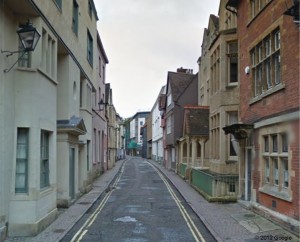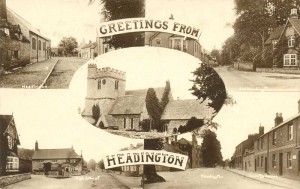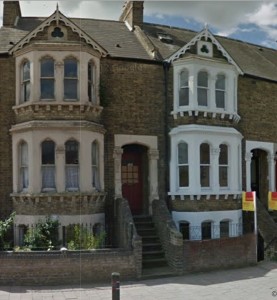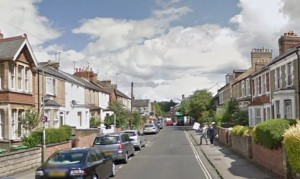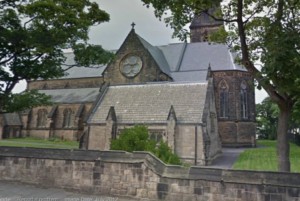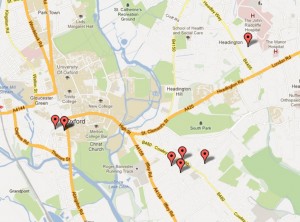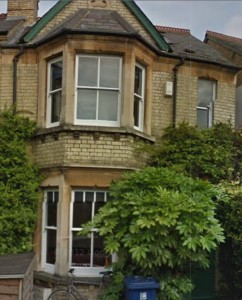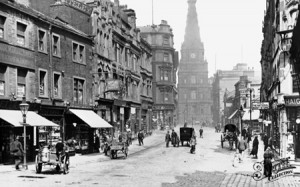Grays
The history of the Gray family and Alice Maude Gray’s forebears is rather extensive and provided on a separate page, see Gray Roots.
ALICE MAUDE GRAY
Alice Maud Gray’s Parents and Siblings in 1881
Some of the dates on this family tree are inconsistent between censuses
Alice Maud Gray was the maternal grandmother of David, Frank, Ian, and Hugh. She was born at Oxford in 1876 and was the youngest of ten children. Her eldest brother, William Matthew Gray, was to become Mayor of Oxford in 1927 – 1928, see here and here. A consequence of this is that the family evidently had some standing in the community and there is more historical information about the Grays on the internet than is the case with some other branches of our family, see here for instance. When David, Frank, Ian and Hugh were children the Matthew Grays were a well established Oxford family and the proprietors of a busy Oxford building firm. I can remember visiting their builder’s yard as a small child.
At the time of the 1871 Census and before Alice Maude was born her parents were living at 27 Pembroke Street, Cowley, Oxford. They had had eight children within a period of twelve years, namely: William (12), Harriet (11), Walter (10), Joseph (8), Charles (6), George (4), Albert (2), and John (1). All the children except the two youngest were at school and all were born at Cowley, Oxford. The father was classified as a builder employing 26 men and 8 boys. He must have had a substantial business because he and two of his brothers, ‘were carpenters and builders who moved from Great Milton to the rapidly developing Cowley St John and were probably responsible for some of Oxford’s “base and brickish skirt”’, see here.
Alice Maud Gray was a late addition to the family and was born at Headington, Oxford, in 1876 during the registration period October to November, for the history of Headington including plenty of images, see here. At some time the family must have moved to a more substantial property because on the 1881 Census they were living at 200c Cowley Road, Oxford. Alice Maud was the youngest of ten children. Of her siblings, William, Joseph and Charles were all listed as carpenters, Harriett was housekeeper for her father. George had died in the first quarter of 1878 aged eleven. Walter was no longer at home and I cannot trace him. All the other children were scholars, including four year old Alice Maud.
Alice Maud’s mother died in 1879 aged about 45 when Alice Maud was still an infant. No doubt she would have been worn out by continuous child bearing during her married life.
The Cowley Road address is clearly a substantial property indicating that Matthew Gray was man of some standing and wealth . The occupations recorded on the 1881 Census of the families living in the five houses each side of the Grays were three greengrocers’ assistants, butcher, licensed victuallar, seamstress, house decorator, tailor and coal dealer, two bakers, dressmaker, two tailors, and fruiterer and greengrocer. This suggests that most of the people living in the neighbourhood had their own small businesses or shops. As ever, the frustration with census data is that there are ten year gaps in the record and this is especially annoying in the case with Alice Maud. After her mother’s death one assumes that she remained in the family home and was brought up by older siblings and the housekeeper. As was usual during the late Victorian period she would most likely have left school when she was thirteen. It is evident that at some time there must have been major changes in Alice Maude’s childhood. The family home must have been sold and the members of the family must have dispersed.
By the time of the 1891 Census Alice Maude’s widowed father was living with the family of his eldest son, William, at 114 Bullingdon Road, Cowley.
In that era Alice Maude would have been treated as a young adult and expected to make her own way in the world. An important factor which may help explain her changed circumstances is that it is evident that the Grays were strong Anglicans and were involved with local church life. While one can only speculate, this may help explain the substantial change in Alice Maude’s young life. The next record for Alice Maude is on the same 1891 Census when she was fourteen. She was recorded as working as a servant in the household of a vicar in New Brighton, Cheshire.
At first sight one assumes that this census record is incorrect, if only because she would have had to move some 175 miles from her family home in Oxford. However, there is no doubt that this entry is correct and every check confirms it. Alice Maud was living in the household of the Rev Charles H Hilton Stewart (but Stewar on some records) who was the third incumbent of St James Church in the parish of New Brighton, Wirral, for the church and its history see here. Presumably the family home was in the Vicarage. The church is a typical solid, dour mid-Victorian building.
The vicar must have been a man of some wealth since there were five servants to support him and his wife and their two children. Alice Maud was the under housemaid. One can only speculate about her life at the vicarage. From the social history of that era, see here and here, one could assume that if she had been a typical under housemaid she would have worked long hours engaged in heavy household labour. She may have earned about £20 per year. It was quite common at the time for more prosperous families to engage servants whose family homes were some considerable distance away. This was to prevent servants carrying gossip from the ‘big house’ back to their families and the local community. On the other hand, we know that Alice Maud came from a highly regarded and prosperous Anglican family and that she was not destined for a long term career as a servant. And one wonders how many servants a family of four require. My guess would be that she was sent to live and work in the home of an Anglican clergyman so that in return for some domestic duties he could provide tuition and prepare her to become a pupil teacher, see here.
It is very unlikely that Alice Maud was sent to Merseyside in order to ‘get rid of her’. Oxford and the Gray family remained a strong influence in her life, see map below. She was married in Oxford and returned to teach there for a while after her marriage and eventually she and her husband retired there to a house that was about a mile and a half from the home where she grew up.
A more likely explanation is that the family decided that teaching would be a suitable occupation for her and the move to living with a clergyman’s household was the fist step in the process of becoming qualified. As far as the record goes there is an intriguing eight year hiatus in Alice Maud’s life between her being a servant in a vicarage at New Brighton and getting married at Oxford in 1899. But one can make some informed speculations about her life. We know that she qualified as a teacher and hence she will have spent some five years as a pupil teacher, see here. Therefore it is unlikely that she will have spent much more time as an under housemaid at the vicarage. One does not know if she continued to live at the vicarage while still a pupil teacher or moved elsewhere. She may well have moved because at some place somewhere she must have met her future husband, Arthur, who at that time was living some distance away from Alice Maude. Before he went up to Cambridge University Arthur was living at Sheffield and after he graduated in 1896 he went on to work as an instructor of pupil teachers at Halifax. New Brighton is some 80 miles from Halifax and 85 miles from Sheffield. It is tempting to think that Arthur met Alice when he was supervising pupil teachers. Alternatively we know that Arthur, too, had a strong Anglican background and it could have been that they met through church activities. It was an era when marriages could still, in a loose sense, be arranged and it may be that Alice Maude was singled out as a suitable partner for Arthur.
Alice Maude married Arthur Stringer in the October – December quarter of 1899 at Headington, Oxford.
Where the newly married couple lived after their marriage is not recorded but the 1901 Census indicates that they were living apart at that time. Alice Maud was boarding at 33 Bartlemas Road, Headington, Oxford. The building is a substantial Victorian mid terrace house. The house belonged to Ann Hubbard, aged 89. Alice Maude was described as married and a school teacher. There was another boarder, a dress maker, also living in the house. Bartlemas Road is about a quarter of a mile from Alice Maude’s childhood home and just over a mile from the house the Stringers eventually retired to 35 years later, see here. For some reason the young couple must have had to live apart but presumably the reason why Alice Maud chose to live in Oxford was the family connection. However, it is interesting to note that she did not board with any of her Gray relations in the locality. The separation from Arthur must have been temporary and cannot have lasted for long because Alice Maud moved to Halifax to be with her husband and the Stringer’s first child a son, Henry Staniland (but always known as Harry), was born there in 1902.
Alice Maud and Arthur Stringer spent their married life up until the time of Arthur’s retirement in County Durham, see here. However Alice Maude’s Oxford family connections must have endured and remained strong because the couple retired to Oxford in 1936. They moved to 31, Staunton Road, Oxford which was within easy walking distance of the area of Oxford and the family homes which Alice Maude knew as a child. Perhaps our mother, Muriel Stringer, also moved with them because she and Henry McNamara were married at Oxford in 1937 and Staunton Road is the witness address on Henry and Alice’s wedding certificate. Moreover, their son, Harry, who suffered from mental problems, was resident in an asylum in Oxford.
During the Coventry blitz, circa 1940/2 David and Frank and their mother were evacuated to Staunton Road. Probably my earliest memory is after the blitz being transported back from Oxford to Coventry in a baker’s van driven by our father. It belonged to Mr Holamby, a family friend who was a caterer and baker; an invaluable person to have know during the war years.


